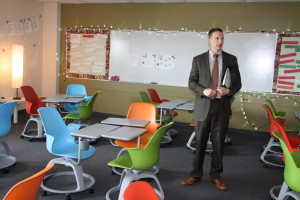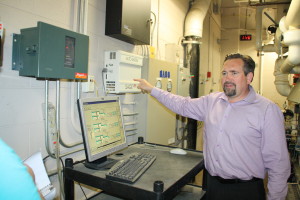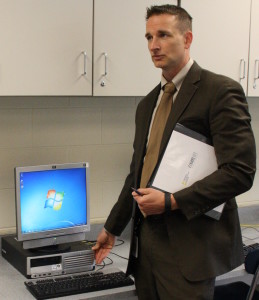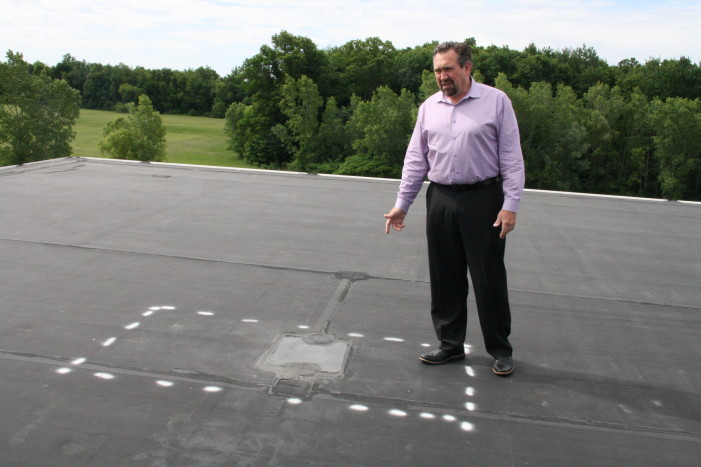Wes Goodman shows an example where patching has been done in the Clarkston High School roof. Photo by Trevor Keiser
Voters head to the polls on Aug. 2 to decide on a $75 million school bond proposal. The Clarkston News is touring the school district to see where and why it is needed. In the first of a series, we check out Clarkston High School.
Out of the $75 million Clarkston Community Schools’ Bond Proposal, $17.8 million would go to upgrades at Clarkston High School.
Building & Site Improvements
The bond proposal includes a new high school roof.
“The total square footage of the high school roof areas including the out buildings is 226,100 square feet,” said Wes Goodman, executive director of operations for the school district. “We have $2.5 million estimated in roof replacement districtwide.”
The current rubber roof, which is 18 years old, came with a 10 year-warranty. They’re looking to get 25-30 years

out new roofs, with a 20 year warranty.
“The technologies in rubber and everything else has become much better,” he added.
Deputy Superintendent Shawn Ryan said they re-patch spots on the roof, but as those spots fail, they replace ceiling tiles where leaks have occurred as quickly as possible.
“We’re definitely not Detroit with buckets and some of the challenges they face with lack of investment,” Ryan said. “But in our community I feel like we’re trying to do our best to try and keep everything kind at a level people expect. Expectations are very high.”
In order to turn CHS into a “21 Century Learning Environment,” the bond proposal also includes classroom furniture.
Ryan said an example of the new furniture that they would like to get for some of the classrooms was English Teacher Laura Mahler’s classroom, which had brightly covered chairs of different colors on wheels with desks attached to them. Ryan said Mahler had purchased the furniture through grant money.
“This is a combination of saying ‘hey we need new desks,’ but we have ones going on 30 years old,” he added. “It’s time to replace it and can we replace it with stuff that is kind of forward thinking.”
Ryan said the desks on wheels come in handy for group project because within seconds students can go from sitting in rows to turning and teaming up with a partner or a group.
“This is quite the contrast to some of the classrooms where students are sitting in old metal folding chairs because over the years chairs have broken.
Classroom furniture is listed at $1.4 million in the budget. There is also $1.5 million in additional fixtures furnishings and equipment throughout the school
So what happens to the old furniture? According to Goodman they start by offering it to other buildings or departments.
“If there are no takers we try to auction, then donate,” he said. “As a last resort, we throw out or recycle.”
Other building and site improvements include ADA/barrier free upgrades, LED lighting and sensors to improve operational efficiency a new clock system for $246,000.
Safety & Security
The district is looking to make entry ways more “secure.” At the high school, visitors are buzzed in and greeted by a person at a desk, ready to direct them where to go.
“If you have an influx of people coming in, it’s hard to stop everybody,” said Goodman. “Naturally there would be another set of doors, so when you got here then you could be buzzed into the school.”
Goodman said the idea would be to buzz people through the first set of doors be able to converse with them, check identifications and then give them a visitor badge and buzz them through the second set of doors. According to the budget, the secure entry addition would cost $228,000. There is also $2.5 million costs for additional new construction and remodeling costs
Part of securing the building also includes classroom door hardware upgrades ($110,000), where teachers would have the ability to lock their doors from the inside, should the school have to go into “lockdown.” They would also upgrade their current security camera systems.
“Many of them are very old,” he said. “In today’s world you store digitally, but these are all analog (cameras), so we’re converting from an analog image to a digital image so we can store it, but the quality is not good.”
Goodman said CHS currently has 100 cameras. The replacement cost will be $150,000 plus two security televisions for the office for $2,000.
Some other safety and security needs include building card access, improving sidewalks to buildings, vehicular and bus traffic flow, parking lots and parking lot lighting upgrades, which will cost approximately $1.5 million.
Educational Technology
Just over $1.1 million will be spent on technology at the high school, which will include, audio/visual systems, network

infrastructure, and staff/student lab device upgrades.
“A majority of the desktop computers students are working on are at least eight years old. They are slow and genuinely need to be replaced,” said Angela Harrison, district administrator of technology. “Those machines currently have the Windows XP operating system, which is no longer supported by Microsoft. Increased access to WiFi needs to be available at all of the buildings. With the addition of new technology, the district electrical system will need to be upgraded to support the new tools.”
Once system upgrades are done, Harrison said students will be able to connect to district networks for educational purposes from their own devices. She said CHS will function a lot like a college campus.
“We believe it is about increasing access for students and not about 1:1. It is about using a variety of technology tools to enhance the learning process,” she added. “As far as devices, it will be a combination of using wha

t the district provides and what the students would like to bring to school for educational purposes.”
Harrison said the Michigan Department of Education guidelines set the useable life for computers and other technology devices at five years.
“The process to upgrade the district’s technology equipment will be completed over multiple years,” she said. “Networks and telephone systems will be operational.”
Included in technology, noted Goodman, is an upgrade to obsolete computer systems controlling heating and cooling.
“We can control every valve, every damper and every motor by computer,” he explained. “It’s original to 1998 and runs on Windows 95. The problem with that is that Windows 95 computers are getting harder and harder to come by and the system won’t work without that,”
The problem, Goodman said, is the older technology “won’t speak” with newer technology.
“What I tell my guys is now you can talk to six different languages. Before it was English is English. You put a German part in there and they wouldn’t talk,” he said. “Today’s networks, you can put in all the languages in there and they all talk, so you’re not as proprietary or locked into a system that only speaks one.”
CHS was built in 1998 with a capacity of 2,019 students. This past year there were 1,889 students enrolled.
“We project a flat to slightly decreasing enrollment over the next 3-5 years,” Ryan said.
The National Center for Educational Statistics says that a school building is “typically considered functionally obsolete” at age 60.
“Life expectancy is tough because there are so many variables in building materials, design flexibility and the ability to provide items like proper electrical power which are also factors in the life of a building,” Goodman said.
The bond also includes $2.8 million for stadium renovations and other sports upgrades. GMB Architecture and Engineering prepared a master capital list including a long-range 10-year plan for all district needs.
For a complete list of bond items and cost, visit www.clarkston.k12.mi.us. See next week’s edition for details on Sashabaw Middle School.

